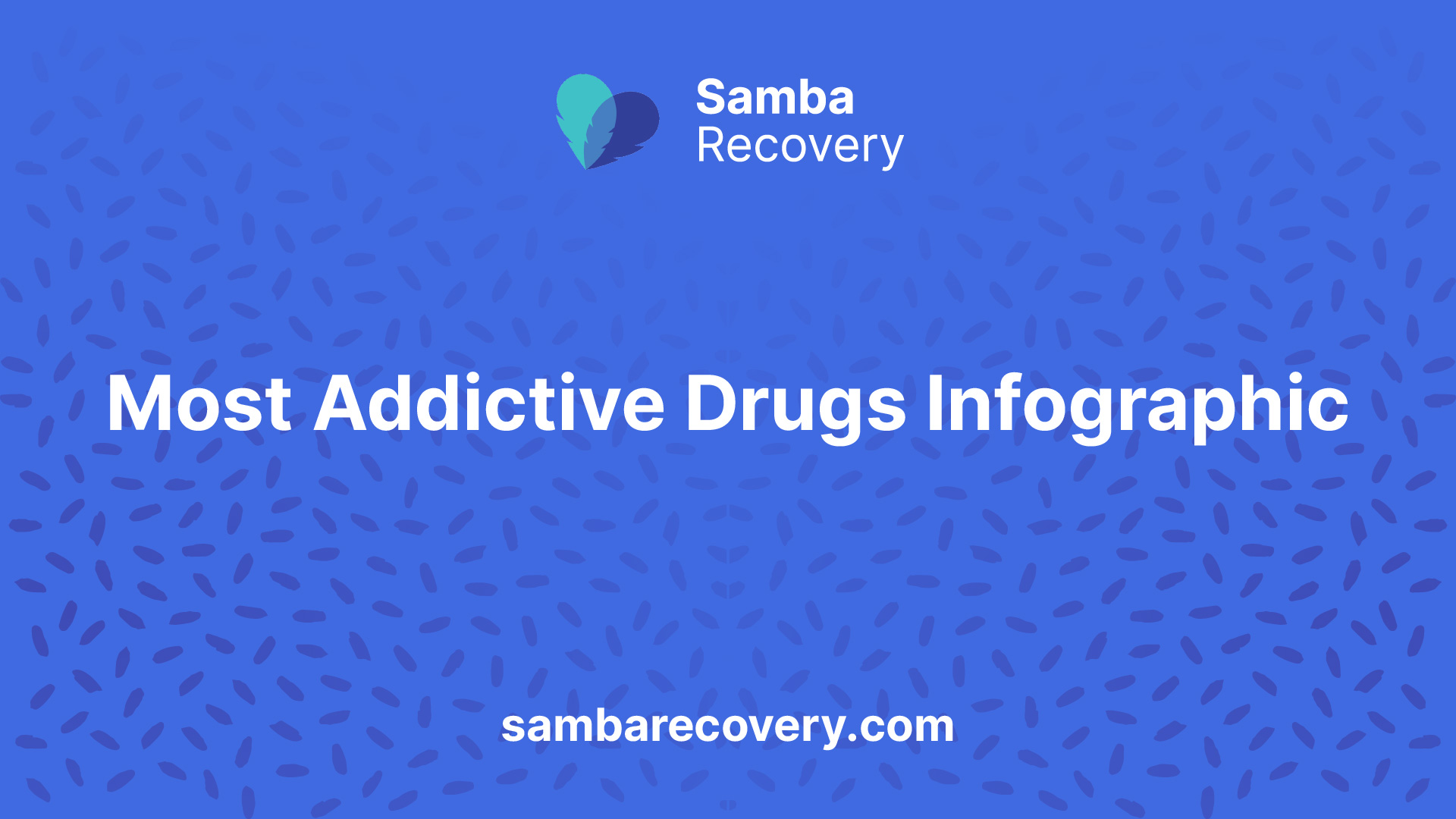Understanding Addiction
Before diving into the details of the most addictive drugs, it’s crucial first to understand what addiction is and how it impacts the brain.
Definition of Addiction
Addiction is a chronic disease characterized by drug seeking and use that is compulsive, or difficult to control, despite harmful consequences. While the initial decision to take drugs is voluntary for most people, repeated drug use can lead to brain changes that challenge an addicted person’s self-control and interfere with their ability to resist intense urges to take drugs. It is a chronic and often relapsing disease linked to pathological changes in neural circuitry, including those involved in reward, motivation, learning, memory, cognitive control, decision making, mood, and interoceptive awareness.

Brain Changes and Addiction
Most drugs affect the brain’s “reward circuit,” causing euphoria as well as flooding it with the chemical messenger dopamine. A properly functioning reward system motivates a person to repeat behaviors needed to thrive, such as eating and spending time with loved ones. Surges of dopamine in the reward circuit cause the reinforcement of pleasurable but unhealthy behaviors like taking drugs, leading people to repeat the behavior again and again.
As a person continues to use drugs, the brain adapts by reducing the ability of cells in the reward circuit to respond to it. This reduces the high that the person feels compared to the high they felt when first taking the drug—an effect known as tolerance. They might take more of the drug to try and achieve the same high.
Long-term drug use causes changes in other brain chemical systems and circuits as well, affecting functions that include decision-making, judgment, learning, memory, and behavior control.
Understanding the intricacies of addiction and how drugs alter the brain’s normal functioning lays the foundation for understanding why certain drugs are more addictive than others. In the next section, we will explore some of the most addictive drugs and how they interact with the brain’s reward system.
Most Addictive Drugs
In understanding addiction, it’s crucial to shed light on the substances that are most addictive. Through this article, we will explore the most addictive drugs, including heroin, cocaine, methamphetamine, MDMA (Ecstasy), LSD, and alcohol.
Heroin
Heroin stands as one of the most addictive substances. It is considered the most addictive drug in the nation today, with nearly 5.1 million people using it in 2015 alone. The impact of heroin addiction is particularly alarming, with deaths due to heroin overdose increasing more than sixfold between 2002 and 2015.
Cocaine
Cocaine is a powerful and addictive drug that poses a significant problem worldwide. Over 14 million people are reported to use it globally. What’s more, 21 percent of people who try cocaine will become addicted at some point in their lives.
Methamphetamine
Methamphetamine, often referred to as meth, is an extremely addictive stimulant amphetamine drug. The high produced by meth is associated with increased energy and euphoria, but it can also lead to dangerous health effects and severe addiction.
MDMA (Ecstasy)
MDMA, commonly known as Ecstasy, is a synthetic, psychoactive drug. It shares similarities with both the stimulant amphetamine and the hallucinogen mescaline, creating an effect of increased energy, pleasure, emotional warmth, and distorted sensory and time perception. However, its addictive potential should not be underestimated.
LSD
LSD (lysergic acid diethylamide) is a potent hallucinogenic drug, also known as a psychedelic. It alters awareness, thoughts, and feelings, leading to hallucinations. Despite its profound effects on perception, it’s less addictive than other substances on this list. However, frequent use can lead to tolerance and psychological dependence.
Alcohol
Alcohol, despite being legal and widely available, is a highly addictive substance. It’s the most commonly used addictive substance in America, with over 17.6 million users. The scale of alcohol addiction is vast – one in every 12 adults suffers from dependence or addiction to alcohol. Its toll on health is significant, with a death rate of over three million per year.
The impact of these addictive substances on individuals and society is profound and far-reaching. The following sections will discuss the health consequences, social implications, economic burden, and treatment options related to addiction.
Impact of Addiction
The consequences of substance addiction are far-reaching, affecting not only the individuals addicted but also their families, communities, and society as a whole. This section will delve into the health consequences, social implications, and economic burden resulting from addiction to the most addictive drugs.
Health Consequences
Addiction to drugs can have devastating effects on a person’s health. Most drugs affect the brain’s “reward circuit,” causing euphoria and flooding it with the chemical messenger dopamine. A properly functioning reward system motivates a person to repeat behaviors needed to thrive. However, surges of dopamine in the reward circuit caused by drug use reinforce pleasurable but unhealthy behaviors, leading to repeated drug use.
Long-term drug use causes changes in other brain chemical systems and circuits as well, affecting functions that include decision-making, judgment, learning, memory, and behavior control.
For example, alcohol, a highly addictive substance, is associated with a death rate of over three million per year. It is the most commonly used addictive substance in America, with over 17.6 million users. One in every 12 adults suffers from dependence or addiction to alcohol.
Social Implications
The social implications of substance addiction are equally alarming. Relationships can be strained or destroyed, and trust can be eroded. Addicted individuals may isolate themselves from their loved ones, which can lead to loneliness and further dependence on drugs.
Addiction can significantly impact a person’s ability to function at work or school, often leading to job loss or academic failure. This can result in financial hardships that can exacerbate the social and emotional stress experienced by the addicted individual and their families.
Economic Burden
The economic burden of drug addiction is substantial. This burden encompasses the direct costs of healthcare and treatment for addicted individuals, as well as indirect costs, such as lost productivity and the societal costs of crime and law enforcement associated with drug use.
According to the National Institute on Drug Abuse, the economic burden of substance abuse in the United States exceeds $600 billion annually. This includes costs related to crime, lost work productivity, and healthcare.
In conclusion, the impact of addiction to the most addictive drugs is profound, affecting numerous aspects of individual and societal health and wellbeing. It’s important to increase awareness of these impacts to motivate prevention efforts and encourage those struggling with addiction to seek treatment.
Factors Influencing Addiction
The development of addiction to the most addictive drugs is influenced by a complex interplay of genetic, environmental, and health-related factors. Understanding these factors can aid in prevention strategies and treatment options for substance use disorders.
Genetic Factors
Studies have shown that addiction often “runs in families” and is attributed in large part to additive genetic factors. Scientists are in the process of identifying genes that influence the risk for addiction, with several replication studies emerging on candidate genes.
The Transmissible Liability Index (TLI), a valid and reliable scale that is highly predictive of substance use disorder, has been identified as a measure of a transmissible trait related to addiction risk. It’s worth noting that the liability to addiction is dynamic over time and development, forming an ontogenetic trajectory influenced by familial, genetic, psychosocial, and other factors.
Environmental Influences
Environmental factors also play a significant role in the development of addiction. These factors can include socio-economic conditions, peer influences, availability of substances, and cultural connections. For example, Native American elders believe that addiction issues arise when individuals lose connection to their culture and heritage, and those who remain closely connected to both sets of cultural values tend to have fewer difficulties with alcohol or drug concerns.
Co-occurring Disorders
The occurrence of addiction is also often linked to co-occurring mental health disorders. This connection can be due to common risk factors, self-medication, or the effects of substance use on the brain. For instance, addiction is a chronic and often relapsing disease linked to pathological changes in neural circuitry, including those involved in reward, motivation, learning, memory, cognitive control, decision making, mood, and interoceptive awareness.
By taking into account these factors, it becomes clear that the fight against addiction to the most addictive drugs requires a comprehensive approach that addresses genetic predispositions, environmental influences, and health conditions. It is a crucial step towards the development of effective prevention and treatment strategies.
Diagnosis and Treatment
The process of diagnosing and treating drug addiction is multifaceted, involving a comprehensive evaluation, a range of treatment options, and various therapeutic approaches.
Diagnostic Process
Diagnosing drug addiction, also referred to as substance use disorder, requires a thorough evaluation. This often includes an assessment by a psychiatrist, a psychologist, or a licensed alcohol and drug counselor Mayo Clinic.
Blood, urine, or other lab tests may be utilized to assess drug use. However, they are not diagnostic tests for addiction. Instead, they serve as tools for monitoring treatment and recovery. For the formal diagnosis of a substance use disorder, most mental health professionals use the criteria outlined in the Diagnostic and Statistical Manual of Mental Disorders (DSM-5), published by the American Psychiatric Association.
Treatment Options
Treatment programs for substance use disorder typically offer withdrawal therapy. The primary aim of this therapy is to facilitate individuals in ceasing the use of the addictive drug as quickly and safely as possible Mayo Clinic.
The detoxification process may involve gradually reducing the dose of the drug or temporarily substituting it with other substances such as methadone, buprenorphine, or a combination of buprenorphine and naloxone.
In cases of opioid overdose, naloxone can be administered to temporarily reverse the effects of the opioid drugs. Different forms of naloxone, such as a nasal spray (Narcan, Kloxxado) and an injectable form, are available.
Medicinal treatment options for opioid addiction may include buprenorphine, methadone, naltrexone, and a combination of buprenorphine and naloxone. These medicines can help reduce cravings for opioids and aid in recovery, although they do not cure opioid addiction.
Therapeutic Approaches
Therapeutic approaches to treating drug addiction are crucial components of a comprehensive treatment plan. These approaches can vary depending on the individual’s unique needs and circumstances, and may include a combination of individual therapy, group counseling, educational classes, and supportive services.
Behavioral therapies can be particularly effective in helping individuals to change their attitudes and behaviors related to drug use, enhance their life skills to handle stressful situations and environmental cues that may trigger intense craving for drugs, and improve their communication, parenting, and vocational skills.
By understanding the diagnostic process, treatment options, and therapeutic approaches, individuals struggling with addiction can navigate their path to recovery more effectively. It’s important to remember that recovery is a lifelong process, and each person’s journey is unique. The benefits of seeking treatment for drug addiction are immeasurable and can lead to a healthier, happier, and more fulfilling life.
Addiction Among Demographic Groups
In the context of addiction to the most addictive drugs, it’s important to consider demographic factors. These can strongly influence patterns of drug use and addiction. This section will explore the prevalence and characteristics of substance use disorders among various demographic groups in the United States.
White Americans
White Americans, particularly white men, experience the highest rates of opioid misuse and deaths from opioid overdose. In 2020, an estimated 47,304 white Americans succumbed to an opioid overdose. This alarming statistic may be attributed to the lack of effective addiction treatment in rural areas, where a vast majority (92%) of addiction treatment facilities are located in urban locations.
Black Americans
There has been a significant increase in marijuana use among Black Americans, particularly those aged 26 and older. However, this rise in usage has not been accompanied by a corresponding increase in marijuana use disorders. Notably, nearly 95% of Black Americans diagnosed with a substance use disorder did not seek out or receive addiction treatment [5].
Hispanic and Latino Americans
Among Hispanics and Latino Americans who abuse substances and have a co-occurring mental health disorder, there is a higher likelihood of experiencing suicidal thoughts, plans, and attempts, irrespective of age. The co-occurrence of substance use and mental health disorders in this demographic is associated with increased suicidal behaviors.
Native Americans
According to Native American elders, addiction issues often arise when individuals lose connection to their culture and heritage. Those who maintain a close connection to both sets of cultural values tend to have fewer problems with alcohol or drug concerns [5].
These findings underscore the importance of taking a culturally sensitive approach to addiction treatment. Tailoring interventions to the unique needs and experiences of different demographic groups could enhance the effectiveness of these efforts and help combat the devastating impact of addiction.
References
[1]: https://nida.nih.gov/publications/drugfacts/understanding-drug-use-addiction
[2]: https://www.ncbi.nlm.nih.gov/pmc/articles/PMC2930133/
[3]: https://www.ashleytreatment.org/rehab-blog/most-addictive-drugs/
[4]: https://nida.nih.gov/research-topics/commonly-used-drugs-charts






